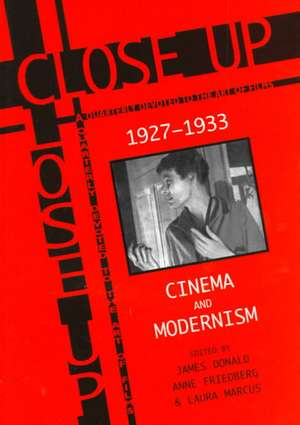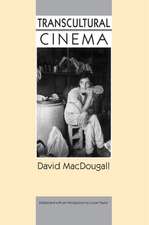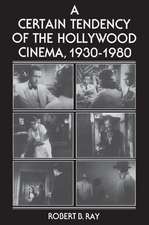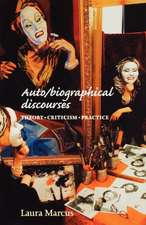"Close Up" 1927-1933: Cinema and Modernism
Editat de James Donald, Laura Marcus, Anne Friedbergen Limba Engleză Paperback – 13 apr 2015
Preț: 441.34 lei
Nou
Puncte Express: 662
Preț estimativ în valută:
84.46€ • 88.21$ • 70.03£
84.46€ • 88.21$ • 70.03£
Carte tipărită la comandă
Livrare economică 07-13 februarie 25
Preluare comenzi: 021 569.72.76
Specificații
ISBN-13: 9780691004631
ISBN-10: 0691004633
Pagini: 352
Dimensiuni: 170 x 245 x 24 mm
Greutate: 0.76 kg
Ediția:Revised
Editura: Princeton University Press
Locul publicării:Princeton, United States
ISBN-10: 0691004633
Pagini: 352
Dimensiuni: 170 x 245 x 24 mm
Greutate: 0.76 kg
Ediția:Revised
Editura: Princeton University Press
Locul publicării:Princeton, United States
Cuprins
| Preface | ||
| Introduction: Reading Close Up, 1927-1933 | 1 | |
| Pt. 1 | Enthusiasms and Execrations | |
| Introduction | 28 | |
| As Is (July 1927) | 36 | |
| British Solecisms | 41 | |
| Emak Bakia | 43 | |
| An Interview: Anita Loos | 48 | |
| A New Cinema, Magic and the Avant Garde | 50 | |
| The French Cinema | 57 | |
| The Aframerican Cinema | 65 | |
| The Negro Actor and the American Movies | 73 | |
| Pt. 2 | From Silence to Sound | |
| Introduction | 79 | |
| The Sound Film: A Statement from U.S.S.R. | 83 | |
| The Sound Film: Salvation of Cinema | 87 | |
| Why 'Talkies' Are Unsound | 89 | |
| As Is (October 1929) | 90 | |
| Pt. 3 | The Contribution of H.D. | |
| Introduction | 96 | |
| The Cinema and the Classics | 105 | |
| Conrad Veidt: The Student of Prague | 120 | |
| Expiation | 125 | |
| Joan of Arc | 130 | |
| Russian Films | 134 | |
| An Appreciation | 139 | |
| Pt. 4 | Continuous Performance: Dorothy Richardson | |
| Introduction | 150 | |
| Continuous Performance [unnumbered and untitled] (July 1927) | 160 | |
| Dawn's Left Hand, reviewed by W. B. [Bryher] | 209 | |
| Pt. 5 | Borderline and the POOL Films | |
| Introduction | 212 | |
| Borderline: A POOL Film with Paul Robeson | 221 | |
| As Is (November 1930) | 236 | |
| Pt. 6 | Cinema and Psychoanalysis | |
| Introduction | 240 | |
| Mind-growth or Mind-mechanization? The Cinema in Education | 247 | |
| Film Psychology | 250 | |
| Freud on the Films | 254 | |
| The Film in Its Relation to the Unconscious | 256 | |
| Dreams and Films | 260 | |
| Kitsch | 262 | |
| Pt. 7 | Cinema Culture | |
| Introduction | 270 | |
| The Independent Cinema Congress | 274 | |
| Russian Cutting | 277 | |
| 'This Montage Business' | 278 | |
| First Steps Towards a Workers' Film Movement | 281 | |
| Films for Children | 283 | |
| What Can I Do? | 286 | |
| How I Would Start a Film Club | 290 | |
| A Note on Household Economy | 294 | |
| Towards a Co-operative Cinema: The Work of the Academy, Oxford Street | 296 | |
| Modern Witch-trials | 299 | |
| Acts under the Acts | 301 | |
| Pt. 8 | Fade | |
| What Shall You Do in the War? | 306 | |
| App. 1 | The Contents of Close Up, 1927-1933 | 310 |
| App. 2 | Notes on the Contributors and Correspondents | 315 |
| App. 3 | Publishing History and POOL Books | 318 |
| App. 4 | A Chronology of Close Up in Context | 319 |
| Notes | 322 | |
| Index | 337 |
Recenzii
During its brief life Close Up attracted exceptional contributors and much admiration. . . . This book is overdue.
"During its brief life Close Up attracted exceptional contributors and much admiration... This book is overdue."--The New Republic
"During its brief life Close Up attracted exceptional contributors and much admiration... This book is overdue."--The New Republic










